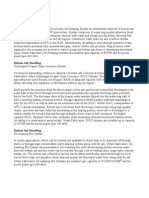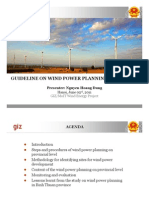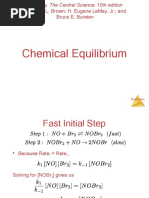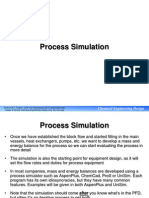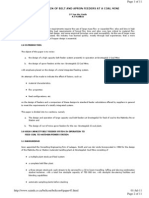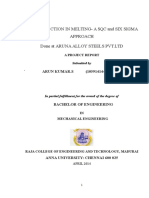The Rheology of Cementitious Materials
The Rheology of Cementitious Materials
Uploaded by
Ai VietCopyright:
Available Formats
The Rheology of Cementitious Materials
The Rheology of Cementitious Materials
Uploaded by
Ai VietOriginal Title
Copyright
Available Formats
Share this document
Did you find this document useful?
Is this content inappropriate?
Copyright:
Available Formats
The Rheology of Cementitious Materials
The Rheology of Cementitious Materials
Uploaded by
Ai VietCopyright:
Available Formats
The Rheology of Cementitious Materials
by Robert J. Flatt Sika Technology Zurich, SWITZERLAND Nicos S. Martys Building and Fire Research Laboratory National Institute of Standards and Technology Gaithersburg, MD 20899 USA and Lennart Bergstrm Institute for Surface Chemistry, YKI Stockholm, SWEDEN
Reprinted from MRS Bulletin, Materials Research Society, Vol. 29, No. 5, pp. 314-318, May 2004. NOTE: This paper is a contribution of the National Institute of Standards and Technology and is not subject to copyright.
www.mrs.org/publications/bulletin
The Rheology of
Cementitious Materials
Robert J. Flatt, Nicos Martys, and Lennart Bergstrm
Abstract
The introduction of a new generation of dispersants in concrete allow this material to exhibit self-compacting properties in its fresh state and high durability and mechanical strength in its hardened state. These properties translate into many practical advantages for the construction field. Two of the most important are reducing the ecological impact of this sector of industry and reducing the labor-intensive work associated with placing ordinary concrete by vibration. In this article, it will be shown that knowledge of colloidal science has proven essential in the development of this new generation of dispersants for concrete. Indeed, the polymer molecules used in these dispersants are specifically designed to induce steric repulsion between cement particles, reducing their agglomeration and allowing high workability of fresh concrete prior to setting. While the linkage between interparticle forces and the rheological behavior of cement pastes is still only semiquantitative, recent advances in the modeling of concrete rheology show very promising results in terms of handling aggregates with a wide distribution of particle sizes and shapes. However, accurate modeling requires reliable input on the interaction of the dispersant with the hydrating cement at the molecular level, which is identified as a future research challenge. Keywords: cement, colloids, construction materials, rheology, aggregates.
Self-Leveling / Self-Compacting Concrete
Nowadays, it is possible to optimize the properties of fresh concrete with the use of superplasticizers to combine a high flowability at very low additions of water with negligible segregation of the particles. This type of concrete, which is usually referred to either as self-compacting concrete (SCC) or self-leveling concrete (SLC), can be cast into a frame of reinforced steel without the need for the labor-intensive vibration usually associated with concrete placing. The introduction of SCC in the last few decades has enabled the development of new construction technologies. For example, the speed of construction of the 238-m-high Roppongi Hills Mori Tower in Tokyo is illustrated in Figure 1. In this case, the building structure consists of steel tubes, 2 m in diameter, which were filled with concrete to increase dimensional stability. The use of SCC made it possible to cast sections of up to 100 m in height without segregation of the aggregates due to gravity.
Ecological Benefits
Superplasticizers are able to reduce the porosity of the final material by allowing the concrete to become workable with less water. This greatly enhances the durability of the concrete, which extends the life cycle of the infrastructure in which it is used, thereby reducing the ecological impact of the construction sector.1 Furthermore, superplasticizers also make it possible to substitute substantial volumes of cement with industrial-waste materials such as slag, fly ash, and silica fume, which reduces the CO2 emissions associated with cement production.
Introduction
When explaining what concrete is to students, the analogy to baking a fruitcake turns out to be quite useful. Both materials contain solid inclusions (aggregates in concrete, versus fruit or nuts in a fruitcake) and a binder (cement versus dough). In both cases, the consistency of the batter may be improved by adding water, and as a result, the porosity of the final product is increased. While in the case of fruitcake this porosity may be an advantage, particularly if the recipe calls for soaking the cake with brandy or kirsch after baking, it can prove catastrophic to the durability of concrete. Indeed, it is through the porous network of the cement paste that chemical agents can enter concrete and cause its degradation. Furthermore, increased porosity of the matrix significantly decreases concrete strength. At first glance, this may suggest that the solution for a more durable concrete is
simply to add as little water as possible. However, while the amount of water required for complete hydration is 2530% of the cement mass, about twice this amount is needed to achieve sufficient workability. This is where dispersants, referred to in this field as superplasticizers or high-range water-reducing admixtures (HRWRAs) come into play. Indeed, the introduction of such admixtures in concrete has enhanced the durability, increased the strength, and improved the workability to levels that previously were unattainable.
Architectural Benefits
Concrete, while relatively inexpensive, is unique as a building material because it can be cast in a wide variety of shapes and sizes. Furthermore, because the use of superplasticizers improves workability and mechanical properties through water reduction (see the article by Vernet in this issue), architects can now exploit completely new designs for elegant structures with normal load-bearing capacities.
Need for Predictability and Robustness
The benefits mentioned here produce a market drive for higher-performance concrete with enhanced workability. However, as performance requirements rise, the robustness of the mix design becomes a more critical issue. This brings with it a growing need for predictability in concrete properties and the a priori selection of concrete components as well as their proportioning,
Benefits of Using HRWRAs in Concrete
In this section, the practical advantages to the construction sector of using high-range water-reducing admixtures are outlined. The mechanisms by which these advantages are achieved in materials terms are discussed in the following sections of this article.
314
MRS BULLETIN/MAY 2004
The Rheology of Cementitious Materials
Figure 1. Series of photographs showing the speed of construction of the 238-m-high Roppongi Hills Mori Tower in Tokyo (completed in 2003). The use of self-compacting concrete made it possible to cast sections of up to 100 m in height without segregation of the aggregates due to gravity. (Photographs courtesy of M. Danzinger; personal communication).
in order to match the requirements of the design while minimizing sensitivity to variations in materials supply.
Concrete Rheology and the Role of Superplasticizers Nature of Superplasticizers
The original introduction of superplasticizers into concrete was accidental. Carbon black had been added to concrete to change the color of the center line of a three-lane highway. In doing so, the concrete had poor workability, and a dispersant was introduced to counter the effect of the carbon black. The resulting hardened concrete showed properties that indicated that the cement had been positively affected by the dispersant;2 the workers probably had added less water because of the enhanced dispersion, and thus higher strength was obtained in the hardened material. It is now common practice to use these additives to improve the flowability and extend the working time of fresh concrete.3,4 The use of the first generation of superplasticizersfor example, sulfonated naphthalene formaldehyde (SNF) and modified lignosulfonates (LSs)resulted in significant improvements in the properties of fresh concrete, and they are still widely used. However, increasing demands for better flowability, extended working time, and a reduction in concrete porosity have created a need for superplasticizers with improved performance.
forces between the cement grains, silica fume, fly ash, and slag particles may originate from van der Waals5 or electrostatic forces (ion correlation, see the article by Pellenq and Van Damme in this issue), or from surface-charge inhomogeneities. The term electrosteric stabilization is often used to describe how superplasticizers act as dispersants. Electrosteric stabilization is a combination of an electrostatic double-layer repulsion and a steric repulsion, where the relative importance of the respective contributions is closely related to the polymer segment density profile at the interface, the charge density of the polymer, and the ionic strength of the solution. To prevent particles from coming into close proximity with each other, this force must be sufficiently long-range. In cementitious systems, where the ionic strength is high ( 0.1 mol/L), electrostatics alone do not suffice. Thus, it is expected that extending the layer thickness of adsorbed superplasticizers should improve their rheological performance in such systems.6,7 This may be achieved with comb-type superplasticizers in which adsorption is driven by the ionic content of the backbone and the steric layer is enhanced by grafted nonadsorbing side chains that extend into the solution (Figure 2).
in relevant solution conditions. The atomic force microscopy (AFM) method for measuring surface forces was first used by Ducker et al.8 They attached a spherical particle at the tip of the cantilever and obtained a force-displacement curve from the deflection of the cantilever as a function of intersurface separation. This versatile method was recently extended to spherical MgO particles,9,10 which have a similar surface chemistry as cement but have the advantage of being much less reactive when subjected to water.11 Figure 3 shows the results from directforce measurements between a spherical MgO probe attached to the cantilever and a flat MgO substrate immersed in an aqueous media at pH 10.12 It was found that the interaction is repulsive in a simple monovalent electrolyte (KCl), which probably can be related to the positive charge on the MgO surfaces (Figure 3a) and low attractive van der Waals forces. However, the addition of calcium resulted in an attraction between the surfaces that may originate from ion correlation forces, as described in the article by Pellenq and Van Damme in this issue. The addition of a comb-like copolymer having a negatively charged backbone with grafted poly(ethylene oxide) (PEO) chains of a relatively short length (PCP1) resulted in a stronger repulsion between the surfaces (Figure 3b). No attraction was observed, even in a calciumrich electrolyte. Addition of a comb-like copolymer having an identical backbone to PCP1 but with PEO side chains of a much longer length (PCP4) results in a interparticle repulsion that is much more long-range (Figure 3c). In addition, the effect of this polymer is influenced relatively little by the nature of the polyelectrolyte. This indicates that the steric repulsion is dominating and we can even get an indication of the thickness of the adsorbed layer on the surface. These results are currently being used in the design of superplasticizers with an optimal structure and can also be used for realistic estimates of the interparticle forces in larger-scale simulations of the rheology of particulate suspensions, as described in the section on Interparticle Interactions/ Yield Stress.
AFM for Probing Properties of Adsorbed Polymers
From the previous discussion, it is clear that an important factor in the dispersion efficiency of superplasticizers is their adsorbed conformation. While computational methods such as molecular dynamics may provide insight into such phenomena in the long term, it is currently more practical to measure the interaction between superplasticizer-coated surfaces directly
The Role of Particle Size Distribution
While the addition of superplasticizers greatly improves concrete rheology through dispersion of the finer particles, the granular nature of concrete must not be overlooked.13 Concrete contains particles of different types, spanning several orders of magnitude is size ( 50 nm for silica fume to 50 mm for the largest aggregates). Thus, rheology
Dispersion Mechanisms
Superplasticizers adsorb at the solid liquid interface between the particles and the aqueous phase. There, they impart a repulsive interparticle force, thus reducing or eliminating adhesion between particles in close proximity.4 The attractive
MRS BULLETIN/MAY 2004
315
The Rheology of Cementitious Materials
may be improved by better grading and proportioning of the components.14,15
Incompatibilities
While dispersion mechanisms appear well understood in general terms, many
details remain unresolved, in particular, cementsuperplasticizer incompatibility.3 This term refers to specific combinations of cement and superplasticizers that show poor rheological properties unless excessive amounts of polymer are added, or for
which the duration of the dispersion effect is extremely short. These incompatibilities arise from the reactivity of cement and in particular from the calcium aluminate phases, which have the strongest initial reaction in the presence of water. The influence of the cement chemistry on superplasticizer performance is well established4,16 and is attributed in part to the intercalation of the superplasticizers into hydration products.17 The intercalated polymer is lost for dispersion purposes and this decreases efficiency.18 In other cases, the efficiency of some polycarboxylates can be lowered because of competitive adsorption from sulfate ions.19
Modeling
A detailed simulation of concrete rheology, accounting for the motion of the cement, sand, and aggregates, is impossible on present-day computers. To solve the computational problem of the broad span of particle sizes in concrete, a multiscale or homogenization approach is used. Phenomena are modeled at a characteristic length scale to determine an average property, which is then used as an input in a simulation at a coarser scale. For example, if the viscosity of a mortar can be determined by simulation or experiment, that viscosity can be used as an input to determine the viscosity of concrete. There are problems with this approach, mainly linked to agglomeration.20 However, at sufficiently high shear rates, the evolution of an agglomerating system is similar to that of a non-agglomerating system. For cementitious materials that exhibit a Bingham behavior (a linear relation between shear stress and shear rate), plastic viscosity is the most relevant rheological parameter, and the slope of experimental flow curves can be compared to those of simulations.
Figure 2. Schematic illustration of the force between two surfaces with adsorbed comb-like copolymers, as a function of separation distance. Steric repulsion prevents van der Waals interactions from developing strong attractive forces (negative values). Schematic illustrations (top) show surfaces (from right to left) before, at the onset, and during the overlap of their adsorbed layers, leading to steric hindrance that overcomes the van der Waals force. The dashed line in the graph is for a thinner adsorbed layer, which is shown before overlap-upon-layer-overlap in the lower illustration. The structure inset at lower right gives the generic composition of such comb-type copolymers.
Suspensions Model Based on Dissipative Particle Dynamics
While some analytical solutions describing the rheological properties of simple suspensions exist (e.g., for very dilute suspensions), understanding the flow of more complex suspensions like cement-based materialsdense suspensions and suspensions composed of particles with different shapes or particles that interactremains a challenge. A major difficulty in modeling complex fluids like suspensions is the tracking of boundaries between the fluid and solid phases. Recently, a promising new computational method called dissipative particle dynamics (DPD)21 has been developed for modeling complex fluid systems. Indeed, DPD may have advantages over other computational fluid
Figure 3. Atomic force microscopy colloidal probe results between MgO surfaces at pH 10: (a) without superplasticizer, (b) in the presence of PCP1 [short side chains of poly(ethylene oxide), and (c) in the presence of PCP4 (longer side chains of PEO). The errors on such measurements are about 5 N/m.13
316
MRS BULLETIN/MAY 2004
The Rheology of Cementitious Materials
dynamics methods because it can describe moving boundaries without requiring regridding of the computational domain.22 On the surface, DPD looks similar to a molecular dynamics algorithm,23 where particles, subject to interatomic forces, move according to Newtons laws. However, the particles in DPD are not atomistic but instead are a mesoscopic representation of the suspension. The interactions between the particles are described by three classes of forces: conservative, dissipative, and random. The conservative force is a central force, derivable from some potential. The dissipative force is proportional to the difference in velocity between particles and acts to slow down their relative motion, producing a viscous effect. The random force (usually based on a Gaussian random noise) helps reproduce the temperature of the system while producing a viscous effect. Finally, it has been shown that DPD equations can account for hydrodynamic behavior consistent with the NavierStokes equations.24,25 To model a rigid-body inclusion in a fluid, a subset of the DPD particles are initially assigned a location in space such that they approximate the shape of the object.26 The motion of these particles is then constrained so that their relative positions never change. The total force and torque are determined from the DPD particle interactions, and the rigid body moves according to the Euler equations. Cement-based materials are usually composed of particles with a broad shape and size distribution. Figure 4 shows some typical examples. Figure 4a is a system of polydisperse spheres that could correspond to a concrete composed of riverbed aggregates, which are usually rounder and smoother than most aggregates. Figure 4b is based on realistic images of aggregates acquired by x-ray microtomography of a crushed aggregate. The tomographic images of aggregates can be analyzed for their geometrical properties by constructing a spherical harmonic representation of their shape.27 Once the aggregate images are incorporated into the code, we can determine the viscosity of the total system relative to the matrix fluid viscosity for a given shear rate. So far, we have found good agreement with experimental studies of the plastic viscosity of fresh concrete having an aggregate composition similar to that used in the simulations28 (Figure 5).
Figure 4. Example of concrete systems: (a) system of polydisperse spheres, corresponding to a concrete composed of riverbed aggregates, which are usually rounder and smoother than most aggregates; (b) model based on three-dimensional images of realistically shaped particles, acquired by x-ray microtomography of crushed aggregates.
ticles. For example, by including an approximation to the attractive van der Waals force expected in cementitious systems,5 it is possible to produce a Bingham-like behavior in our suspension. To model the steric hindrance of dense layers, where interpenetration is low before the van der Waals force is counteracted, a cutoff distance is introduced at close separation. While more refined models need to be developed, the results of these preliminary
investigations are encouraging. Ultimately, we expect to be able to use conformational data of adsorbed superplasticizers from AFM within such predictions.
Conclusions
In this article, we have highlighted two key aspects of concrete rheology: (1) the agglomeration of the finer particles and the role of dispersants to counter this agglomeration and (2) the granular nature of concrete and the role of particle size distributions on the rheological properties of concrete. Mastering both aspects has led to significant progress in concrete technology, raising expectations for concrete properties and highlighting questions of robustness. Consequently, there is an increased need for predicting concrete properties and their variation. In this context, modeling can play a crucial role. The work presented shows promising results in its ability to account for the three-dimensional shapes of particles. While good predictions of plastic viscosity have been obtained, more work is needed to accurately measure the role of yield stress. Ultimately, the model should use structural information about the superplasticizer molecule to properly evaluate interparticle forces. Such tools will not only allow better use of existing materials but will also help admixture producers design superplasticizers with better performance and enhanced robustness. The utility and predictive capability of the models will improve with further advances in our ability to quantify interparticle forces and formulate multiscale models. In the long term, to properly describe cement
Interparticle Interactions/Yield Stress
We are currently investigating the incorporation of interparticle interactions that account for agglomeration of cement par-
Figure 5. Comparison of relative plastic-viscosity values from a simulation of coarse aggregate gradings and experimental measurements using different concrete rheometers. In the figure, Grad. #1, #2, and #3 correspond to gradations of spherical aggregates used in the computer simulation. BML is a coaxial concrete rheometer, IBB is a vane concrete rheometer, and beads in paste corresponds to measurements of monosized glass beads in a cement paste using a parallel plate rheometer. The solid line is included as a guide for the eye.28
MRS BULLETIN/MAY 2004
317
The Rheology of Cementitious Materials
rheology, the inclusion of other features such as the reactivity of cement and the perturbation of dispersant efficiency though intercalation or adsorption competition from other species needs to be taken into account.
References
1. P.K Mehta, in Proc. of the 6th CANMET/ACI International Conference on Fly-Ash, Silica Fume, Slag and Natural Pozzolans in Concrete, Vol. 1, edited by V.M. Malhotra (American Concrete Institute, Detroit, 1998) p. 1. 2. V.H. Dodson, Concrete Admixtures (Van Nostrand Reinhold, New York, 1990). 3. P.C. Atcin, C. Jolicoeur, and J.G. MacGregor, Concr. Int. 16 (5) (1994) p. 45. 4. V.S. Ramachandran, V.M. Malhotra, C. Jolicoeur, and N. Spiratos, Superplasticizers: Properties and Applications in Concrete, CANMET Publication MTL 97-14 (CANMET, Ottawa, 1998). 5. R.J. Flatt, Cem. Concr. Res. 34 (2004) p. 399. 6. R.J. Flatt, in Polymers in Particulate Systems: Properties and Applications, edited by V.A. Hackley, P. Somasundaran, and J.A. Lewis (Marcel Dekker, New York, 2001) p. 247. 7. J.A. Lewis, H. Matsuyama, G. Kirby, S. Morissette, and J.F. Young, J. Am. Ceram. Soc. 83 (2000) p. 1905. 8. W.A. Ducker, T.J. Senden, and R.M. Pashley, Nature 353 (1991) p. 239. 9. A. Kauppi, P.F.B. Banfill, P. Bowen, L. Galmiche, Y.F. Houst, F. Lafuma, U. Mder, F. Perche, B.G. Petersen, K. Reknes, I. Schober, A. Siebold, and D. Swift, in Proc. 11th Int. Congr. on the Chemistry of Cement, Vol. 2, edited by
Acknowledgments
The authors thank colleagues in their respective institutions for support in the fundamental investigations in this field and for fruitful discussions and comments, in particular, at Sika Technology, Dr. Norman Blank, Dr. Irene Schober, and Dr. Urs Mder; at NIST, Dr. Chiara Ferraris, Dr. Edward Garboczi, Dr. Steve Satterfield, and Dr. Terrance Griffins; and at YKI, Dr. Anika Kauppi. N. Martys also acknowledges support from VCCTL (the Virtual Cement and Concrete Testing Laboratory, NIST) for modeling work. AFM results presented here were obtained with EU support under the project Superplast (Project of the 5th European Framework Programme, G5RD-CT-2001-00435). L. Bergstrm and R. Flatt are also grateful to all of their colleagues within that project for many fruitful discussions.
G. Grieve and G. Owen (Cement Association of Canada, Ottawa, 2003) p. 528. 10. A. Kauppi, K.M. Andersson, and L. Bergstrm, Probing the Effect of Superplasticizer Adsorption on the Surface Forces Using the Colloidal Probe AFM Technique, Cem. Concr. Res. submitted for publication. 11. R.J. Flatt, Y.F. Houst, P. Bowen, H. Hofmann, J. Widmer, U. Sulser, U. Maeder, and T.A. Brge, in Proc. 5th CANMET/ACI Int. Conf. on Superplasticizers and Other Chemical Admixtures in Concrete, edited by V.M. Malhotra (American Concrete Institute, Detroit, 1997) p. 743. 12. H.G. Pedersen, Particle interactions: An AFM study of colloidal systems, PhD thesis, Technical University of Denmark, 1998. 13. H. Van Damme, S. Mansoutre, P. Colombet, C. Lesaffre, and D. Picart, C.R. Physique 3 (2002) p. 229. 14. T.C. Powers, The Properties of Fresh Concrete (John Wiley & Sons, New York, 1968). 15. F. de Larrard, Concrete Mixture Proportioning: A Scientific Approach (E&FN Spon, London, 1999). 16. D. Bonen and S.L. Sarkar, Cem. Concr. Res. 25 (1995) p. 1423. 17. V. Fernon, A. Vichot, N. Le Goanvic, P. Colombet, F. Corazza, and U. Costa, in Proc. 5th CANMET/ACI Int. Conf. on Superplasticizers and Other Chemical Admixtures in Concrete, edited by V.M. Malhotra (American Concrete Institute, Detroit, 1997) p. 225. 18. R.J. Flatt and Y.F. Houst, Cem. Concr. Res. 31 (2001) p. 1169. 19. K. Yamada and S. Hanehara, Concr. Sci. and Eng. 3 (2001) p. 135. 20. R.J. Flatt, Towards a Prediction of Superplasticized Concrete Rheology, Mater. and Struct. in press. 21. P.J. Hoogerbrugge and J.M.V.A. Koelman, Europhys. Lett. 19 (1992) p. 155. 22. R. Peyret and D. Taylor, Computational Methods for Fluid Flow (Springer-Verlag, New York, 1983). 23. M.P. Allen and D.J. Tildesley, Computer Simulation of Liquids (Clarendon Press, Oxford, 1987). 24. P. Espaol and P. Warren, Europhys. Lett. 30 (1995) p. 191. 25. C. Marsh, G. Backx, and M.H. Ernst, Europhys. Lett. 38 (1997) p. 441. 26. J.M.V.A. Koelman and P.J. Hoogerbrugge, Europhys. Lett. 21 (1993) p. 363. 27. E.J. Garboczi, Cem. Conc. Res. 32 (2002) p. 1621. 28. C. Ferraris and N. Martys, J. Res. Natl. Inst. Stand. Technol. 108 (2003) p. 229.
318
MRS BULLETIN/MAY 2004
You might also like
- E-Coat Simulation STAR 2013Document35 pagesE-Coat Simulation STAR 2013Jessica Estephany Medina Salce100% (1)
- Study On Strength Properties of Self-Compacting Concrete With Micro SilicaDocument6 pagesStudy On Strength Properties of Self-Compacting Concrete With Micro SilicaSajin Bs0% (1)
- Effect of Fly Ash On Properties of Self-Compacting High Strength Lightweight ConcreteDocument7 pagesEffect of Fly Ash On Properties of Self-Compacting High Strength Lightweight ConcreteShahid IqbalNo ratings yet
- Influence of Zinc Sulphate in Microstructure and Strength Properties ofDocument16 pagesInfluence of Zinc Sulphate in Microstructure and Strength Properties ofjayakrishnajg001No ratings yet
- Applied SciencesDocument17 pagesApplied SciencesDanielNo ratings yet
- Chemical Admixtures Today Mario Collepardi, Enco, Engineering Concrete, PonzanoDocument22 pagesChemical Admixtures Today Mario Collepardi, Enco, Engineering Concrete, PonzanoAravindan KrishnamoorthyNo ratings yet
- 13 AnnexuresDocument23 pages13 Annexurespratik chauhanNo ratings yet
- Durability of SCCDocument8 pagesDurability of SCCAlireza AzarioonNo ratings yet
- Seminar Report FinalDocument22 pagesSeminar Report Finalshaaz v s m100% (1)
- Experimental Studies On High Strength Concrete by Using Recycled Coarse AggregateDocument10 pagesExperimental Studies On High Strength Concrete by Using Recycled Coarse AggregateinventyNo ratings yet
- Performance Optimization of Hybrid Fiber Concrete - Felxural - Compullout - High Temp.Document18 pagesPerformance Optimization of Hybrid Fiber Concrete - Felxural - Compullout - High Temp.Prasanth SekarNo ratings yet
- Mechanical Properties of Fiber-Reinforced Concrete Using Composite BindersDocument14 pagesMechanical Properties of Fiber-Reinforced Concrete Using Composite Bindersamirdz76No ratings yet
- Bendable ConcreteDocument8 pagesBendable ConcreteAnees CalicutNo ratings yet
- Materials 14 06071 v2Document26 pagesMaterials 14 06071 v2Vandal RayNo ratings yet
- Fresh Properties With Fly AshDocument10 pagesFresh Properties With Fly AshSaulatJillaniNo ratings yet
- Structural Glass Fiber Reinforced Concrete For Slabs On GroundDocument8 pagesStructural Glass Fiber Reinforced Concrete For Slabs On GroundYusuf TrunkwalaNo ratings yet
- Concrete AssignmentDocument24 pagesConcrete AssignmentPushpesh RanjanNo ratings yet
- Durability of Concrete With Differential Concrete Mix DesignDocument10 pagesDurability of Concrete With Differential Concrete Mix Designshoyeeb ahmedNo ratings yet
- Study The Variation of Properties of Concrete Mix Using Binding Material Portland CementDocument7 pagesStudy The Variation of Properties of Concrete Mix Using Binding Material Portland CementIJRASETPublicationsNo ratings yet
- 14 Trend Concrete PDFDocument44 pages14 Trend Concrete PDFFanny Aulia RahmanNo ratings yet
- Wang S Li VC 07 Engineered Cementitous Composites With High-Volume+Document9 pagesWang S Li VC 07 Engineered Cementitous Composites With High-Volume+Basil Baby-PisharathuNo ratings yet
- Experimental Study On Concrete by Using Polymer and Partial Repalcement of M.sandDocument7 pagesExperimental Study On Concrete by Using Polymer and Partial Repalcement of M.sandIJRASETPublicationsNo ratings yet
- KONTOLEONTOS Et. Al (2012) - Influence of Colloidal Nanosilica On Ultrafine Cement Hydration - Physicochemical and Microstructural CharacterizationDocument14 pagesKONTOLEONTOS Et. Al (2012) - Influence of Colloidal Nanosilica On Ultrafine Cement Hydration - Physicochemical and Microstructural CharacterizationKimberley HollandNo ratings yet
- INFLUENCE of Microsilica and Nano Silica in Concrete MixturesDocument27 pagesINFLUENCE of Microsilica and Nano Silica in Concrete MixturesSwathi Sv100% (1)
- The Effects of Natural Perlite Aggregate and Perlite Powder On The Properties of Structural Light-Weight ConcreteDocument10 pagesThe Effects of Natural Perlite Aggregate and Perlite Powder On The Properties of Structural Light-Weight ConcreteDharma banothuNo ratings yet
- Study On Durability Characteristic Strength of Recycled Waste Concrete As Fine Aggregates in Self-Compacting ConcreteDocument8 pagesStudy On Durability Characteristic Strength of Recycled Waste Concrete As Fine Aggregates in Self-Compacting ConcreteIJRASETPublicationsNo ratings yet
- Thesis On Lightweight ConcreteDocument5 pagesThesis On Lightweight Concretechristinamartinspringfield100% (2)
- 37 45 4311 Ali April 2024 116Document9 pages37 45 4311 Ali April 2024 116marwakareemNo ratings yet
- Experimental Study Light Weight Concrete Using LECA, Silica Fumes, and Limestone As AggregatesDocument10 pagesExperimental Study Light Weight Concrete Using LECA, Silica Fumes, and Limestone As AggregatesIJRASETPublicationsNo ratings yet
- 4096-Article Text-20292-1-10-20210531Document11 pages4096-Article Text-20292-1-10-20210531janhvi muleNo ratings yet
- Ultra Strength ConcreteDocument10 pagesUltra Strength ConcreteJ S Kalyana RamaNo ratings yet
- Supplementary Cementitious VikramDocument13 pagesSupplementary Cementitious VikramgiiriidhariiNo ratings yet
- Concrete Types in Morden ConstructionDocument7 pagesConcrete Types in Morden ConstructionAkshay Kumar Sahoo100% (2)
- A Review On Self Compacting Concrete WitDocument6 pagesA Review On Self Compacting Concrete WitAarya JadhavNo ratings yet
- Effect of Silica Fume On Mechanical Properties of High-Strength ConcreteDocument11 pagesEffect of Silica Fume On Mechanical Properties of High-Strength ConcreteMmm HhhhNo ratings yet
- EffectofCalciumNitrateonthePozzolanicPropertiesofHighEarlyStrengthConcreteDocument8 pagesEffectofCalciumNitrateonthePozzolanicPropertiesofHighEarlyStrengthConcretePremalatha JeyaramNo ratings yet
- Admixtures and SustainabilityDocument11 pagesAdmixtures and SustainabilityJohn GiannakopoulosNo ratings yet
- ThesDocument44 pagesThesRediff mailNo ratings yet
- Application of Ductile FiberDocument8 pagesApplication of Ductile FiberAndreea BadulescuNo ratings yet
- Effect of Sporosarcina Pasteurii On Rheological and Strength Properties of Bio-Self Compacting ConcreteDocument12 pagesEffect of Sporosarcina Pasteurii On Rheological and Strength Properties of Bio-Self Compacting ConcreteInternational Journal of Innovative Science and Research TechnologyNo ratings yet
- Influence of Graphite NanoDocument4 pagesInfluence of Graphite NanoIkram FarooqNo ratings yet
- Exploring Synergistic Effects and Hydration Mechanisms in Metakaolin Blended Cement SystemsDocument13 pagesExploring Synergistic Effects and Hydration Mechanisms in Metakaolin Blended Cement SystemsHenry Felipe Velandia LarrottaNo ratings yet
- Analysis of Mechanical and Microstructural Properties of High Performance Concretes Containing Nanosilica and Silica FumeDocument15 pagesAnalysis of Mechanical and Microstructural Properties of High Performance Concretes Containing Nanosilica and Silica FumeAnyela MolinaNo ratings yet
- Construction and Building MaterialsDocument15 pagesConstruction and Building MaterialsJoe Alcantara RomeroNo ratings yet
- Self Compacting Concrete For Slip Form PavingDocument7 pagesSelf Compacting Concrete For Slip Form PavingNaufal Pawa NajibNo ratings yet
- Experimental Study On Steel Fibre Reinforced Concrete by Partially Replacement of Cement With GGBS and MetakolinDocument44 pagesExperimental Study On Steel Fibre Reinforced Concrete by Partially Replacement of Cement With GGBS and MetakolinB VAMSI KRISHNANo ratings yet
- Report On Summer RainingDocument16 pagesReport On Summer RainingAr G S YadavNo ratings yet
- Strength Study On Fiber Reinforced Self-Compacting Concrete With Fly Ash and GGBFSDocument5 pagesStrength Study On Fiber Reinforced Self-Compacting Concrete With Fly Ash and GGBFSSchool of EngineersNo ratings yet
- Reasearch Paper 1Document9 pagesReasearch Paper 1Angelo Mike John JavinezNo ratings yet
- 3D Printing ConcreteDocument60 pages3D Printing Concrete109-Sai KannaNo ratings yet
- Utilisation of Ultra-High Performance Fiber ReinfoDocument9 pagesUtilisation of Ultra-High Performance Fiber ReinfoSoham RotheNo ratings yet
- Properties & Applications of CeraCem Ultra High PerformanceDocument10 pagesProperties & Applications of CeraCem Ultra High PerformanceYuliusRiefAlkhalyNo ratings yet
- MyDocument61 pagesMynvnrev0% (1)
- Influence of Superplasticizers (Conplast Conplast SP 430) On Fresh Properties of Self-Compacting Concrete An Experimental InvestigationDocument6 pagesInfluence of Superplasticizers (Conplast Conplast SP 430) On Fresh Properties of Self-Compacting Concrete An Experimental InvestigationIJRASETPublicationsNo ratings yet
- Mechanical Properties of High Volume Fly Ash Based Fiber Reinforced Self Compacting Concrete: A ReviewDocument7 pagesMechanical Properties of High Volume Fly Ash Based Fiber Reinforced Self Compacting Concrete: A ReviewIJRASETPublicationsNo ratings yet
- October 2015 1448082506 23Document5 pagesOctober 2015 1448082506 23SonuNo ratings yet
- An Experimental Study On Effect of Silica Oxide Nano Particles and Fly AshDocument47 pagesAn Experimental Study On Effect of Silica Oxide Nano Particles and Fly AshRaghu GowdaNo ratings yet
- Toughness improvement of low strength ceramsite lightweight concrete by polypropylene fiber and recycled rubber particleDocument15 pagesToughness improvement of low strength ceramsite lightweight concrete by polypropylene fiber and recycled rubber particletasniaNo ratings yet
- Effect of Silica Fume On Steel Slag Concrete: International Journal of Civil Engineering and Technology May 2018Document9 pagesEffect of Silica Fume On Steel Slag Concrete: International Journal of Civil Engineering and Technology May 2018NM2104TE06 PRATHURI SUMANTHNo ratings yet
- Speak Business English Puzzle 1Document2 pagesSpeak Business English Puzzle 1Ai VietNo ratings yet
- Sales Representive Sales Employee A 500 Employee B 500 Employee C 500 Total Sales Goals Achieved YesDocument1 pageSales Representive Sales Employee A 500 Employee B 500 Employee C 500 Total Sales Goals Achieved YesAi VietNo ratings yet
- Ash HandlingDocument3 pagesAsh HandlingAi VietNo ratings yet
- Wind Handbook Wind Energy Project GIZ PECC3 ENGDocument31 pagesWind Handbook Wind Energy Project GIZ PECC3 ENGAi VietNo ratings yet
- Test Result: M/s.Hyderabad Engineering LabsDocument1 pageTest Result: M/s.Hyderabad Engineering LabsSainath AmudaNo ratings yet
- BASOL Degreasing AgentDocument8 pagesBASOL Degreasing AgenthadiNo ratings yet
- Cis Exp 2Document9 pagesCis Exp 2Osama Bader Al Osoufi100% (1)
- General Chemistry 2 Week 13 14 Chemical EquilibriumDocument54 pagesGeneral Chemistry 2 Week 13 14 Chemical EquilibriumMark Lorens StaanaNo ratings yet
- Sikaflex Construction (J) SealantDocument4 pagesSikaflex Construction (J) SealantFronica Litad SamionNo ratings yet
- Tsytovich, N.A. and Chetyrkin, N.S., 1973. EIGHTH INTERNATIONAL CONFERENCE ON SOIL MECHANICS AND FOUNDATION ENGINEERING (PROLOGUE)Document3 pagesTsytovich, N.A. and Chetyrkin, N.S., 1973. EIGHTH INTERNATIONAL CONFERENCE ON SOIL MECHANICS AND FOUNDATION ENGINEERING (PROLOGUE)mOchO100% (1)
- The Sugars of Honey-A ReviewDocument14 pagesThe Sugars of Honey-A ReviewsedianpoNo ratings yet
- Titration of Sodium Hydroxide With Hydrochloric AcidDocument3 pagesTitration of Sodium Hydroxide With Hydrochloric AcidMir HashemiNo ratings yet
- 20 Zienkiewicz, O. C., Watson, M., and King, I. P., A Numerical Method of Visco-Elastic PDFDocument21 pages20 Zienkiewicz, O. C., Watson, M., and King, I. P., A Numerical Method of Visco-Elastic PDFTariq MahmoodNo ratings yet
- ASTM D 1847-93 Total Chlorine Content of Epoxy ResinsDocument3 pagesASTM D 1847-93 Total Chlorine Content of Epoxy ResinsLisNo ratings yet
- Eng 2159 - Casting Lab ReportDocument14 pagesEng 2159 - Casting Lab Reportphirijerry073No ratings yet
- MercerizationDocument7 pagesMercerizationRahadian Noor MadanyNo ratings yet
- 4 Process SimulationDocument70 pages4 Process SimulationsithvincentNo ratings yet
- SDS Lithium DownloadDocument8 pagesSDS Lithium DownloadSorin CurtutNo ratings yet
- Lit SLD InstallDocument8 pagesLit SLD InstallchennagotfanNo ratings yet
- Defining The Anthropocene (Lewis 2015) NatureDocument10 pagesDefining The Anthropocene (Lewis 2015) NatureCliffhangerNo ratings yet
- 06 Scope of Work Site Inspn Services RasgasDocument17 pages06 Scope of Work Site Inspn Services RasgasGirijesh Verma100% (1)
- Anisotropic Nanoparticles and Anisotropic Surface Chemistry: AbstractDocument10 pagesAnisotropic Nanoparticles and Anisotropic Surface Chemistry: AbstractMileidy Karina Tuta CristanchoNo ratings yet
- Rules and Standards: German Atv-DvwkDocument25 pagesRules and Standards: German Atv-DvwkMehmet Emre Bastopcu100% (2)
- 2002 RD 1 Questions tcm18-190750Document10 pages2002 RD 1 Questions tcm18-190750LouiseflemingNo ratings yet
- Sutherland RubDocument2 pagesSutherland RubPandi AhmadNo ratings yet
- Experiment 18 Preparation of P-IodonitrobenzeneDocument3 pagesExperiment 18 Preparation of P-IodonitrobenzeneZarba KhanNo ratings yet
- Storage Tank Types and FeaturesDocument50 pagesStorage Tank Types and FeaturesShafiq Ahmad100% (8)
- CELdek Tech Manual GB-0016-0400Document9 pagesCELdek Tech Manual GB-0016-0400maihuongxd100% (3)
- En Penetrant Test ProcedureDocument6 pagesEn Penetrant Test ProcedureAdham AhmedNo ratings yet
- ChuteDesignFormulas Paper43Document11 pagesChuteDesignFormulas Paper43Martin LarochelleNo ratings yet
- Conservation Strategy of Metal Embroidery Threads in Textile Objects in Museum of Jordanian HeritageDocument8 pagesConservation Strategy of Metal Embroidery Threads in Textile Objects in Museum of Jordanian Heritagem_gugeanu1No ratings yet
- A Project Report On Cost Reduction in Melting - A SQC and Six Sigma ApproachDocument107 pagesA Project Report On Cost Reduction in Melting - A SQC and Six Sigma ApproachArun Prince100% (1)































































